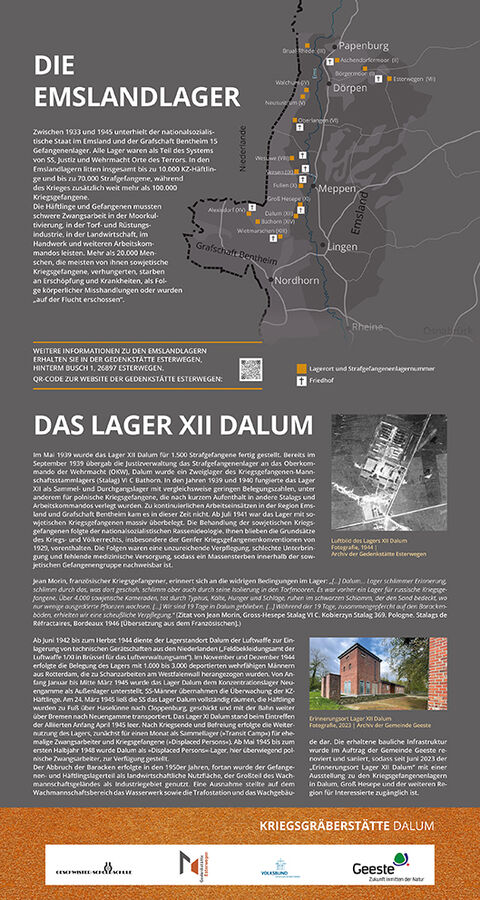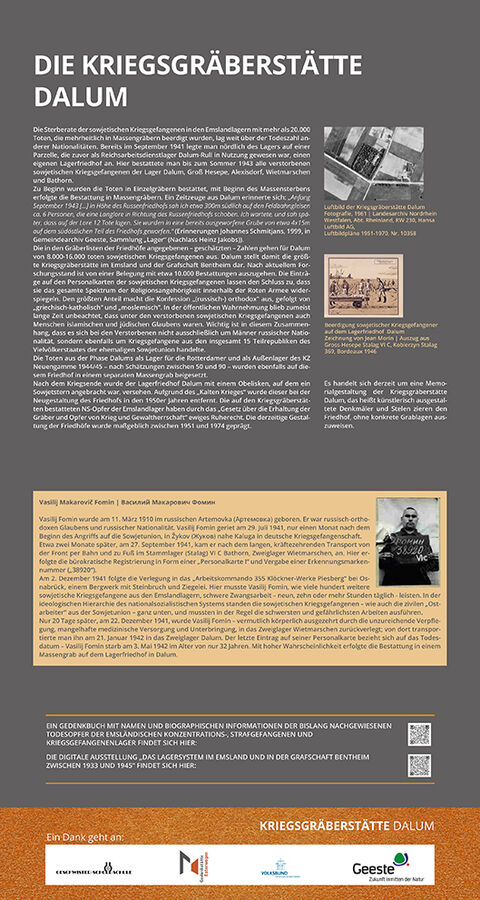War Cemetery Dalum
The death rate of the Soviet prisoners of war in the Emsland camps, with more than 20,000 dead, was far higher than that of other nationalities. The majority was buried in mass graves. As early as September 1941, a separate camp cemetery was established north of the camp on a plot of land that had previously been used as the RAD (Reichsarbeitsdienst - Reich Labor Service) camp Dalum-Rull. All deceased Soviet prisoners of war from the Dalum, Groß Hesepe, Alexisdorf, Wietmarschen and Bathorn camps were buried here until the summer of 1943.
At the beginning, the dead were buried in individual graves, but when the mass deaths began, they were buried in mass graves. A contemporary witness from Dalum recalled: "At the beginning of September 1943 [...] near the Russian cemetery, about 300 metres to the south, I saw about 6 people on the field railway tracks pushing a long wagon in the direction of the Russian cemetery. I waited and later saw that there were 12 dead bodies on the lorry. They had been thrown into a pit of about 4x15 metres in the south-eastern part of the cemetery." (Memoirs of Johannes Schmitjans, 1999, in Geeste municipal archive, ‘Lager’ collection (Heinz Jakobs estate)).
The estimated figures given in the cemetery grave lists for Dalum are 8,000-16,000 dead Soviet prisoners of war. Dalum is therefore the largest war cemetery in Emsland and the county of Bentheim. According to current research, it can be assumed that around 10,000 people were buried there. The entries on the personnel cards of the Soviet prisoners of war allow the conclusion that they reflect the entire spectrum of religious affiliation within the Red Army.
The largest share is made up of the denomination ‘(Russian) Orthodox’, followed by ‘Greek Catholic’ and ‘Muslim’. For a long time, the fact that there were also people of Islamic and Jewish faith among the deceased Soviet prisoners of war went largely unnoticed by the public. It is important to note in this context that the deceased were not exclusively men of Russian nationality, but also prisoners of war from the 15 constituent republics of the multi-ethnic state of the former Soviet Union.
The dead from Dalum's phase as a camp for the Rotterdammers and as a satellite camp of the Neuengamme concentration camp in 1944/45 - between 50 and 90 according to estimates - were also buried in a separate mass grave in this cemetery. After the end of the war, an obelisk with a Soviet star on it was added to the Dalum camp cemetery. Due to the ‘Cold War’, this was removed when the cemetery was redesigned in the 1950s.
The Nazi victims of the Emsland camps buried in the war cemeteries have a perpetual right of rest under the ‘Law on the Preservation of Graves and Victims of War and Tyranny’. The current design of the cemeteries was largely shaped between 1951 and 1974.
Short guided tours:
Every 1st Sunday of the month, at 11am and 3pm. Please contact us in advance for a tour in English.






